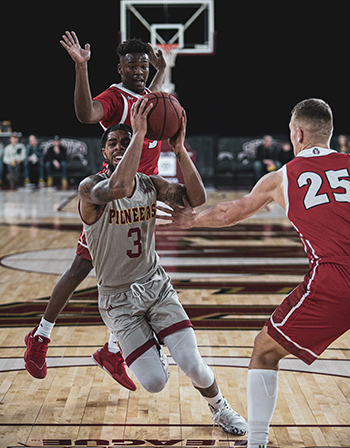Stress Fractures in Basketball

Stress fractures are common injuries seen in both male and female basketball players. One study demonstrated that 7 percent of women’s basketball players at the WNBA combine had sustained at least one stress fracture. Stress fractures can result in a significant amount of lost sports participation time and can often be season ending and, occasionally, career ending.
Unlike traumatic/acute fractures, these fractures develop over time as a result of overuse. Stress fractures often develop with a sudden increase in activity after a period of inactivity or decreased activity. Therefore, pre-training for events or gradual transition back to sport is recommended to help prevent these fractures. Stress fractures can also result from biomechanical abnormalities such as improper shoe wear; improper running, jumping, and landing techniques; the anatomy of the athlete; and inadequate muscle training. Evaluating these factors and the implementation of corrective measures by an athletic trainer, physical therapist, or personal trainer can be helpful for injury prevention.
Nutrition and general health can also play a role in the development of stress fractures. Basketball players, in particular, spend a lot of their training and practice time indoors, so they often do not get the adequate sunlight exposure needed to convert Vitamin D into its active form. Recent research has shown that players can be Vitamin D deficient which may lead to decreased bone density and a predisposition for fractures. Similarly, females with irregular or no menses and eating disorders can develop decreased bone density, again making them more likely to suffer from a stress fracture.
Stress fractures commonly involve the lower extremities in basketball players due to repetitive impact on a hard surface. Multiple types of stress fractures have been reported in basketball players, including fractures of the pelvis, hip, leg, knee, ankle, midfoot, and toes. A stress fracture of the weight bearing tibia bone of the leg is one of the most common types for basketball players. A player who develops a tibia stress fracture complains of a gradual onset of pain over the front, mid-portion of the leg. This usually develops after a period of increased activity.
An X-ray reveals the “dreaded black line” on the front part of the tibia bone. Traditionally, treatment for this type of stress fracture has been a period of rest from activity, with the possible addition of a bone stimulator, for 3–6 months. Varying degrees of success for non-operative treatment have been reported in the literature from excellent results to high failure rates. Some physicians suggest being more aggressive in treating these injuries surgically with the insertion of a rod into the bone to take stress off of the fracture area. The surgery can be successful in curing the pain and healing the fracture, but it still may take the fracture up to 3–6 months to completely heal. There are also risks involved with this surgery, including knee and leg pain along with a non-healing fracture, and/or a complete fracture around the rod. The advantages and disadvantages of each treatment option should be thoroughly discussed with the team physician and orthopaedic surgeon before deciding on a course of treatment.




